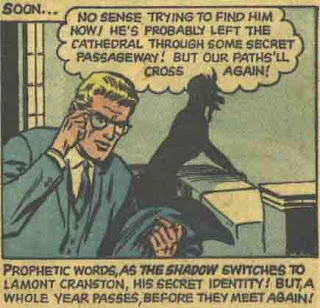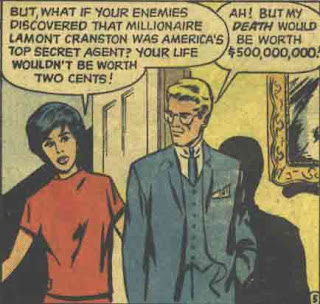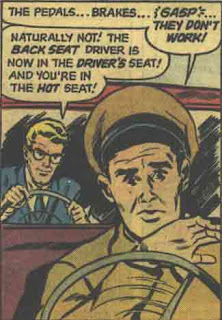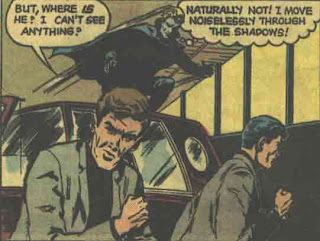Welcome back to my continued feature on Archie Comics' 1964 series
the Shadow. Previously, we were introduced to Archie's version of Lamont
Cranston, wealthy playboy and super-spy who sometimes dons a cape to fight his enemies as the Shadow. We've reached
the Shadow#2, which promises to transform our protagonist into a spandex-wearing super hero!

The cover depicts the Shadow with red hair rather than the blond hair from issue #1. His navy blue costume with green cape, boots, gloves and shorts is perfectly acceptable by the standards of 1960s super hero comics. However, it's a pretty lousy look for the Shadow, who looks eerie and intimidating as a man in a black coat and hat. Since issue #1 established this version of the Shadow can't cloud men's minds so they cannot see him, I wish him well as he tries to hide in the shadows whilst clad in bright green. Also, what exactly is he leaping from? He's in the middle of an airport tarmac, you don't find many high spots away from the planes and terminals! We see Shiwan Khan from issue #1's first story is back again and is menacing Margo Lane, whose hair is still black. Strange that only Lamont's hair has changed colour! The cover promises "the Triangle of Terror!" a "book length novel;" the length of this "book," maybe.

We open our story, "Shiwan Khan's Murderous Master-Plan!" and soon see... well, that today's story is not called "the Triangle of Terror!" Further, we see the Shadow is still a man in a blue suit with a cape. What gives? In the above image, Shiwan Khan is supposedly sitting at a desk in his headquarters, but with his desk upon the raised platform, he seems as though he's a judge in a courtroom.

We begin our story at a private airstrip outside New York City as Shrevy sees Lamont off for a flight on Cranston's private plane. Once the pilot has the plane in the air, Lamont takes over the controls for him so the pilot can have his dinner (there's no co-pilot, despite the size of the cabin). Just after Lamont returns the plane's controls to the pilot, the craft hits some air turbulence, caused by the mushroom cloud of an atomic explosion! Lamont heads to a communications station on the plane and contacts Weston at "a secret central office." Weston says the bomb was set off by Shiwan Khan, but Cranston should continue on course to Hong Kong and pretend to be on his business trip. However, his secret mission is to journey to a small town outside Peking and find a special agent using the password "free world."

Just as Weston's face fades from Cranston's video monitor, an aircraft opens fire on Cranston's plane. Cranston activates an air-to-air missile apparatus, firing a missile which is "impossible to escape." The aircraft being targeted is the same bomber which dropped the a-bomb and piloted by Shiwan Khan himself (how did Weston learn the bomber's identity within minutes of the blast?). Khan's co-pilot compares the pursuing missile to a "shadow," irking his superior. As you can see above, Shiwan Khan's dialogue balloon doesn't make the most economic use of its space; as well, note the use of commas around "shadow."

Shiwan Khan and his co-pilot bail out of the craft before the missile strikes it and they descend to a nearby submarine. Cranston is eager to capture them, intending at first to land via pontoons, but the duo reach their submarine first. Wait, pontoons? On a luxury-sized jet? Cranston looks at the fleeing men through his binoculars, recognizing Shiwan Khan, but when the pilot asks if he saw who they were, he claims he didn't get a good look. Why? If Cranston's status as a secret agent is known to Margo and Shrevy, why not the rest of his staff? Don't they think there's something odd about their millionaire playboy boss having secret video communications mid-flight, being attacked by enemy agents and shooting down said agents with a missile launcher? Is it seriously going to hurt Lamont's double (or triple) life to admit he recognized the internationally-famous master spy Shiwan Khan?

The next day in Hong Kong, Lamont instructs his pilot to drop him via parachute over Fouwong. His pilot surmises his boss isn't making a dangerous clandestine trip into Red China for business reasons, but Lamont can only offer a lame excuse to explain himself: "Call it... er... my passion for sight-seeing!" Lamont, you're consistently terrible at covering up your multiple identities; please, at least consider telling your staff what sort of danger you're bringing them into! Lamont parachutes out at night, wearing a snappy bright green jumpsuit to give the Chinese army a sporting chance at shooting him. Lamont decides he'd better become the Shadow so he can hide... can't he use his Shadow powers at any time, not just when his glasses are off and his cape is on?

Just look at this hopeless panel. Lamont is apparently hidden in the shadows, so his thought balloon emerges from one of the soldiers? Sloppy. Somehow, it works. The text is still very unclear about what exactly the Shadow's powers are, so perhaps he can cloud men's minds? Lamont claims the soldiers are confused at his "disappearance," even though there were no panels depicting him in the soldiers' line of sight. So I guess he did cloud their minds? Anyway, the Shadow shoots out the soldiers' radio, then hypnotizes them, making them think they're inside a cage and unable to call for help. As he does this he finally uses the "clouding men's minds." Aha! Heaven knows what someone who'd never heard of the Shadow would make of this sequence, but we're only three stories into the series and I'm starting to understand what the protagonist's abilities are!

Later, the Shadow knocks out another soldier on the road and steals his uniform and jeep for cover as he enters Fouwong. Why not simply use hypnosis to travel incognito through Fouwong? How likely is it that a blond-haired white man can pass for a soldier, even with the clothing? Lamont has no idea where to find his contact, so he goes to the Dragon's Lair cabaret, hoping he'll draw some attention. Here he finally acknowledges that yes, a white man wandering into a village in communist China is a little conspicuous. Lamont uses his perfect Chinese dialect to get a table near the cabaret singer; she notices him ("like all the rest of her breed." muses the suddenly-misogynist Lamont) and asks to join his table. However, as they share a drink, Lamont begins to feel woozy. The singer leads Cranston out of the cabaret to another location, where he passes out. When Lamont comes to, the singer uses the "free world" password, identifying herself as his contact.

We now begin chapter two of the story, "the Triangle of Terror!" Aha! So the cover didn't exactly lie! Perhaps we'll see Margo Lane and the blue-green spandex yet! The singer reveals she's a freelance agent who'll work for anyone, including Shiwan Khan. This time, she's been hired by the USSR. It seems Khan intends to blackmail China into making him their ruler under the threat of his atomic weapons; the USSR fears if Khan brings down China, they'll be next. Boy, if Khan has this many atomic weapons then stopping him from getting the plans to a US rocket plane (issue #1) seems a lot less important now. The cabaret singer says they need to find Khan's ultimate weapon.

Before they put their plan into motion, Lamont grabs the singer and kisses her. She tells him this is the last time she'll tolerate such behaviour; Lamont retorts "Okay! Next time you kiss me!" But she answers icily "Such a time will never come! I am not interested in romance!" This is the most James Bondian performance by Lamont thus far. The singer's fellow freelancers keep calling her "Princess," so I guess that's her codename?

Suddenly, Princess and her men act as though Lamont has disappeared, even though he's standing in plain sight. Y'know, over in 1964 issues of the Fantastic Four, Jack Kirby never made you wonder whether the Invisible Girl was invisible to her enemies or not, but the creators of the Shadow have no clue how to tell their audience when he's using his powers. Consequently, it's hysterical to see these scenes of Lamont "disappearing" in plain sight. Anyway, Lamont is suddenly wearing his cape and has lost his glasses, so he's the Shadow now. To cover his disappearance, he cries out as Lamont that the Shadow has captured him. This works, because Princess and her men know of the Shadow and that he's an enemy of Shiwan Khan. This from people living in a village in China, whereas in the previous issue, CIA agent Weston thought the Shadow was just a legend! The Shadow grabs Princess and covers her mouth, then hypnotizes her three henchmen so they think each other is Shiwan Khan, causing all three to knock each other unconscious (all three at once? that's some trick).

Now the Shadow turns on Princess to hypnotize her into assisting him with Shiwan Khan (even though she's already offered to help Lamont!). The Shadow forcibly hypnotizes her, theorizing Khan will be trapped by "the bait of [her] beauty!" So, the Shadow's opening salvo is to mind-rape her so Khan can take advantage of her? Pretty skeevy behaviour, Lamont. Now the Shadow just has to find Shiwan Khan! Stepping back into the streets of Fouwong, Lamont "mentally x-rays" passersby until he finds some who are working for Khan. That sounds like an involved task, but the first people he checks are Khan's men. The Shadow orders Princess to surrender to Khan's men and they carry her Khan's mansion, with the Shadow hiding on the rear fender. Why does the Shadow need this deception to find Khan's manor? Couldn't he force the information from the minds of Khan's men?

Princess is brought to Khan and she identifies herself as Princess Lua, hired by the USSR to stop him alongside Lamont Cranston, but she tells Khan the Shadow is present in Fouwong. Again, one wonders why Lamont keeps the Shadow as a separate identity! All of this is according to the Shadow's plan. Lua offers to join forces with Khan to stop the Shadow, plus offers herself as Khan's lover. Lua asks where his "X-bomb" is. So, I guess Khan's super weapon is called the "X-bomb." Khan doesn't actually want to set off the bomb, preferring to ransom the world instead, but Lua suggests he should direct his ultimatum to the Shadow, demanding the Shadow surrender or the X-bomb will explode. The Shadow spends the entire time eavesdropping on Shiwan Khan outside his window while this happens; here's an idea: try using your powers to sneak inside the room, beat up Khan, pull the X-Bomb's location from his mind, then erase his memories. It's nothing you haven't proven capable of doing so far!

Anyway, now that Khan has issued the ultimatum which Lua suggested (and which the Shadow forced her to suggest), he bursts into Khan's lair and begins defeating his henchmen. The Shadow pulls out a second cape and throws it over one of Khan's men, then throws him into Khan's room as a distraction. Khan is guarded by an agent armed with a machine gun. Aha, so that henchman is toast, right? No, he quickly explains the situation to his master and the real Shadow announces his presence. Uh, what was the point of that? And what was the point of the revised ultimatum? Now the Shadow uses his hypnosis to "be-cloud" Shiwan Khan's mind, causing him to forget where he hid the bomb, how he made it and forget everything else he knew about atomic weapons. Khan passes out from this strain, hitting an alarm with his hand. Consequently, the Shadow has to run with Princess Lua to avoid the rest of Khan's guards. What? Why didn't Khan sound the alarm when he knew the Shadow was in his base? And if the Shadow can conceal himself and Lua from detection, why not take Khan along as a hostage? Not that they were able to keep Khan in prison last issue, but he should at least make the effort.

Anyway, Shiwan Khan has lost all memory of his bomb. Princess Lua sees Lamont Cranston off at an airport as she notes Khan can't explode his own bomb. "Right! I took care of everything!" Wait, what? No one's supposed to know you're the Shadow, Lamont! You just took credit for stopping Shiwan Khan! Sigh. Lamont and Princess Lua have their parting of the ways as she warns they may meet as enemies next time "I adore enemies like you!" is Cranston's response. Considering Lua earlier claimed she didn't want romance, I don't think this change of attitude casts the Shadow in a good light.
This is... a pretty crummy story. The divide between Lamont Cranston, millionaire; Lamont Cranston, super-spy; and Lamont Cranston, the Shadow; remains ridiculous, as noted above. The man should have two identities, period. The Shadow's powers remain nebulous, ill-defined and poorly represented by the art. The Shadow using his powers to alter the mind of his own ally is also a very repellent development. I hope the super-spy version of Lamont Cranston is done away with quickly - at this point, I'm eager to see him become a super hero if only to avoid the complications from his being a secret agent. This is a sloppy comic book, muddled by the attempt to fuse a super-spy Bond rip-off into an existing detective super hero. Again, the series lacks tension because the Shadow's powers are so ill-defined and versatile one never believes he's in danger; sure enough, he spent most of this tale hypnotizing his enemies into obeying his will.
Once again, the Grand Comics Database credits the story to Robert Bernstein, the art to John Rosenberger and the cover to Paul Reinman. I don't know what to make of the cover. Clearly they already knew they were going to transition the Shadow into a spandex-clad super hero, but they ran it at least a month early. So, just as last issue's Reinman cover depicted a version of the Shadow who wasn't found in the interior, so does this issue follow suit. At least they didn't lie about Shiwan Khan being the villain! He's... their only villain, after all...
Well, the super hero costume never appeared, but that's the Shadow#2... No, wait, there's a second story in this issue. So much for the "book length" promised on the cover! Man! Okay, next time in "Bitter Fruit," we'll examine the 2nd story in Archie's the Shadow#2.























































